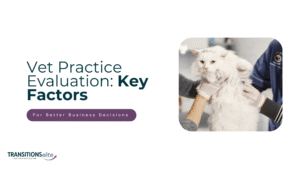Top Canadian Veterinary Consolidators: How Their Offers Stack Up
The veterinary roll-up race has slowed, but the chessboard it left behind is more strategic than ever. VetStrategy acquisition multiples are still the yardstick every broker cites, yet the logic behind them has shifted.
Offers that once seemed uniform now vary widely in structure, timing, and expectations. One buyer might headline an impressive multiple, another attaches performance targets that stretch payments over years. For vet practice owners weighing their first negotiation, the question is no longer who will buy, but how the value is defined.
A single-site practice with tight books may now outscore a bigger but chaotic operation.
For sellers, this reset is both relief and reckoning; premiums still exist, but they must be earned. Knowing how VetStrategy or NVA Canada reads your numbers, your retention record, and even your province’s labour data is what determines the offer that arrives on your desk.
Breaking Down VetStrategy’s Acquisition Multiples
For many practice owners, the phrase “VetStrategy acquisition multiples” has almost become shorthand for what their clinic might be worth. But behind that headline figure sits a mix of capital strategy, deal psychology, and timing that determines whether a seller achieves a premium or a discount.
When Berkshire Partners backed VetStrategy in 2020, analysts estimated the company’s valuation at around 18-22x EBITDA benchmark, a record for Canada’s veterinary space.
That level, however, reflected a large-scale platform sale, not the single-practice market most owners navigate.
The real drivers of the numbers are less mysterious than they appear.
- Clinic size and stability: Buyers pay for predictability. Multi-site operations with consistent cash flow attract higher multiples.
- Specialty capability: Surgical, imaging, or emergency services add margin and long-term growth potential.
- Location: Metro or high-growth suburban areas command premiums; slower markets rarely do.
- Owner retention: Sellers who stay for a transition period are seen as lower risk and often receive stronger valuations.
After 2023, the market adjusted. Rising interest rates made financing costlier, and buyers became more selective. Instead of inflating offers, VetStrategy has leaned on structure using earn-outs and staged payments to preserve valuation discipline without lowering headline multiples.
For sellers, the headline number tells only half the story. The composition of the deal (cash upfront OR performance-based) determines real value. A “20x” deal with 40% tied to growth targets can be worth less than a “15x” offer paid mostly in cash.
For sellers, the best strategy is preparation: clean books, documented EBITDA adjustments, and a realistic understanding of how valuation tiers work. VetStrategy still pays well for quality, but it rewards transparency and operational strength more than optimistic projections.
A seller who knows their true normalised earnings and can show consistent results stands a far better chance of converting the headline multiple into real proceeds. In a market where perception often outruns reality, informed readiness is still the most valuable currency.
Inside NVA Canada’s Buyout Terms: How Their Offers Are Structured
If you’ve ever had an NVA Canada representative reach out about your clinic, you’ve probably noticed how methodical their process feels. There’s none of the pushy tone some sellers expect from consolidators. Instead, they walk through a long list of details: financial records, staffing ratios, even your long-term plans. All of that feeds into how the deal is shaped.
What most owners discover quickly is that the number on the offer sheet isn’t the full story. NVA Canada breaks a purchase into several moving pieces: the cash payment you’ll receive on closing, the portion tied to future performance, and, in some cases, an equity share that lets you stay invested in the group.
Those pieces shift depending on the risk profile of the clinic and how long the seller plans to remain after the sale.
| Deal Component | Typical Range | Purpose |
|---|---|---|
| Cash at Closing | 50-70% | Immediate liquidity for the seller |
| Earn-Out | 20-40% | Rewards post-sale growth and retention |
| Equity Rollover | 5-15% | Keeps sellers invested in the platform’s future |
A general practice in a stable metro market may see a higher upfront payout and a short earn-out period. A smaller, rural clinic might get a lower cash ratio but more contingent value based on future EBITDA.
The contract details matter as much as the numbers.
- Employment terms usually run 12–36 months; that’s how NVA ensures continuity for staff and clients.
- Non-compete clauses average three to five years, scaled by geography.
- About ten percent of the purchase price is often held back for one year to cover post-closing adjustments.
| Bottom Line: What matters is how the payment arrives and how much control the seller keeps after the ink dries. |
Owners who remain with the practice typically fare better. They help hit earn-out targets and maintain goodwill with the team. Those planning a quick exit need to scrutinize every performance clause. In NVA Canada’s system, structure defines value far more than the multiple itself.
Canadian Veterinary Consolidators: Who the Major Players Are in 2025
Over the past decade, veterinary ownership in Canada has shifted from local independence to corporate networks. That shift has introduced scale, investment, and operational systems, but it’s also left sellers wondering who’s behind each offer on their desk.
The chart below captures the most active groups and what differentiates them:
| Consolidator | Ownership / Backing | Approx. Clinics | Acquisition Focus |
|---|---|---|---|
| VetStrategy | Backed by IVC Evidensia (U.K.) | 360 + clinics, 9 provinces | Broad GP roll-up, national scale |
| NVA Canada | Subsidiary of U.S.-based NVA (JAB Investors) | ~140 clinics | Larger GP and specialty practices |
| VCA Canada | Owned by Mars Inc. | ~150 clinics | GP and specialty mix, strong brand presence |
| P3 Veterinary Partners | Private investors | ~40 clinics | Mid-sized GP clinics, steady expansion |
| VetCare Group | Independent investors | ~30 clinics | Emerging player, regional acquisitions |
How They Differ
- VetStrategy runs on volume and national coverage. Their acquisitions often prioritise footprint and long-term integration.
- NVA Canada moves more slowly but targets high-margin or multi-doctor clinics. Their deals are often more structured, with earn-outs or equity options.
- VCA Canada, backed by Mars, blends medical resources with consumer reach, giving sellers global brand security.
- P3 and VetCare remain smaller, often focusing on underserved provinces and more personalised relationships.
What’s Driving Record-High Valuations Among Canadian Veterinary Consolidators
Over the last few years, Canadian veterinary consolidators have transformed simple buyouts into a high-stakes investment category. The average clinic that once sold for ten times EBITDA can now, in the right hands, touch twenty. The forces behind that rise are financial as much as behavioural.
| Market Force | Impact on Multiples | Typical Example |
|---|---|---|
| Private Equity Involvement | Expands acquisition budgets | VetStrategy’s Berkshire-backed platform |
| Clinic Scarcity | Boosts competition | Fewer independent multi-doctor practices are left |
| Growth in Pet Spending | Sustains buyer confidence | 2024 pet-care spend up 14% (Statista) |
| Consolidation Synergy | Raises expected ROI | Shared systems, bulk purchasing, unified HR |
What’s Changed in Recent Years
- Liquidity surplus: Private equity funds view veterinary medicine as recession-resistant. The competition between funds spills over into acquisition pricing.
- Stable demand curve: Unlike elective sectors, pet care doesn’t shrink in downturns; that makes buyers comfortable paying long-term premiums.
- Strategic clustering: Consolidators now pay extra for locations that complete regional networks, even if financials are average.
- Staffing and inflation: Higher labour costs push buyers to prioritise efficient clinics; well-managed teams add tangible value.
After the 2021–22 frenzy, most deals now involve structured payments and careful due diligence. Premiums persist for quality assets, yet weaker clinics are feeling the ceiling.
Think of multiples as confidence indicators, not fixed prices. When a buyer believes your numbers will hold for years, that confidence shows up directly in the multiple. For sellers, recognising which of those levers applies to their own clinic is where the real preparation begins.
EBITDA Multiples Explained: How Canadian Buyers Value Veterinary Practices
Owners often hear that their clinic is worth “twelve times EBITDA” without really knowing what that stands for. EBITDA earnings before interest, taxes, depreciation, and amortisation, are simply a shorthand for the clinic’s cash-flow potential. Buyers use it to compare one practice with another on equal footing, stripping out quirks like tax structure or ownership salary.
How Buyers Adjust the Number
- Normalising earnings: Personal expenses, above-market owner salaries or one-off repairs are removed to find true performance.
- Risk review: If revenue relies heavily on one vet or one location, the multiple shrinks.
- Growth evidence: Proven expansion plans, or new services already underway, add points to the multiple.
- Quality of records: Clean, consistent financials can raise value more than most owners expect.
Why Multiples Fluctuate
A clinic with similar revenue to another may still trade two or three turns apart. That’s because buyers are paying for reliability, not just profit. A predictable 15 percent margin is safer than a volatile 25 percent one. In today’s tighter credit environment, that consistency matters even more. The clearer your earnings story, the more trust a buyer can price into the deal.
Equity Rollovers, Earn-Outs, and Payout Structures in NVA Canada Offers
Anyone reviewing an NVA Canada term sheet quickly realizes how much flexibility is built into their deals. The total price might look impressive, but how that number is divided determines what the seller actually takes home. NVA rarely pays a flat sum, its offers blend cash, future performance rewards, and sometimes a stake in the broader organisation.
| Component | Usual Share of Deal Value | Purpose |
|---|---|---|
| Cash at Closing | 55-70% | Upfront liquidity; secured payment on completion |
| Earn-Out | 20-35% | Contingent on meeting revenue or EBITDA targets over 2-4 years |
| Equity Rollover | 5-15% | Optional reinvestment, letting the seller share in group growth |
The holdback period is usually around ten percent of the sale price for one year, worth confirming early.
Bottom Line: Don’t confuse structure with generosity. A 20× deal sounds remarkable until you realise 40 % of it depends on two years of post-sale targets.
For sellers who see their practice as part of a longer journey, NVA’s structure can be appealing. For those ready to step away (simplicity, more cash, fewer conditions, etc.) usually beats theoretical upside. Either way, understanding how each component works is the key to turning a good offer into a dependable one.
Private Equity’s Expanding Role in Canadian Veterinary Consolidations
Five years ago, selling a veterinary practice usually meant dealing with a regional operator. Today, it’s just as likely that the ultimate buyer reports to a private equity boardroom in Boston, London, or Zurich. PE has moved deep into Canadian veterinary medicine, chasing stable returns and predictable cash flow from pet care.
| Group | Financial Sponsor | Effect on Strategy |
|---|---|---|
| VetStrategy | Berkshire Partners > IVC Evidensia | Built a national footprint; platform now global |
| NVA Canada | JAB Investors | Focus on selective, high-margin acquisitions |
| Smaller entrants (P3, VetCare) | Independent PE and venture funds | Target niche or regional clusters |
Why Investors Love This Space
- Resilient demand: Pet health spending doesn’t shrink in recessions.
- Fragmented ownership: Thousands of independent clinics mean plenty of acquisition targets.
- Recurring revenue: Preventive care and loyalty programs ensure predictable income.
The inflow of capital has been good for valuations but has also made the market more competitive and, at times, more transactional. Large funds want to scale fast, which can pressure integration teams and limit flexibility in smaller deals.
For sellers, PE involvement can mean more sophisticated buyers, stronger infrastructure, faster due diligence, but also less room for negotiation once a deal hits their investment model.
The next phase of this market will likely involve recapitalisations, where PE firms sell their veterinary holdings to new funds. Each handover resets pricing and reshapes who the “big players” are. For practice owners, keeping an eye on which fund owns whom isn’t trivia.
How to Benchmark Your Practice’s Value Before Negotiating with VetStrategy or NVA Canada
Before sitting across from VetStrategy or NVA Canada, you need a clear picture of your practice’s value, one you can prove on paper. Buyers walk in with sophisticated models; the owner who’s done the same earns instant credibility.
| Performance Indicator | Target Range | Interpretation |
|---|---|---|
| EBITDA (Normalised) | 15-25 % of revenue | Core profitability measure |
| Revenue per DVM | $650-750K + | Shows utilisation and demand |
| Client Retention Rate | 85-90% + | Predictability of future income |
| Year-over-Year Growth | 5-10% | Sustainability of the business model |
Building a Benchmark That Holds Up
- Start with normalised EBITDA: Adjust for one-time or personal expenses so buyers see your true earnings power.
- Cross-check with peers: Talk to your accountant or regional consultant; local deal chatter often reveals fair-market ranges.
- Factor in non-financials: Culture, staff loyalty, and facility condition quietly sway valuation as much as spreadsheets do.
- Scenario test your number: Apply a conservative and an optimistic multiple to see what range feels defensible before any offer arrives.
Putting It Into Practice
Walking into a negotiation without a benchmark is like showing up to a marathon without shoes. Buyers sense it immediately. But when you bring real data: clear margins, staffing metrics, growth trends, you’re no longer a hopeful seller; you’re an informed counterpart.
Conclusion
Selling to a corporate consolidator in today’s Canadian market is no longer about chasing the highest multiple. It’s about knowing how your clinic’s value is built and protecting it through clarity, timing (when to sell your vet clinic), and negotiation discipline. Whether you’re dealing with VetStrategy, NVA Canada, or a smaller buyer, the strongest results go to sellers who prepare early: clean books, loyal staff, and consistent performance. Multiples may move with markets, but transparency and preparation remain constant.
In this new phase, information, readiness, and realism will matter far more than timing luck. The sellers who grasp that will set the new benchmark. A well-prepared owner doesn’t just react to offers; they create the conditions that invite better ones.
What are buyers really paying for VetStrategy deals right now?
If you ask how much corporate and PE buyers are willing to pay, then the numbers vary, but most solid GP clinics see offers somewhere around the mid-teens on EBITDA. Bigger or specialty sites sometimes stretch closer to twenty. Smaller, single-doctor clinics usually trade lower because risk and workload still revolve around one person.
How do NVA Canada’s deal terms usually look?
They rarely hand over everything in one cheque. Expect most of the price at closing, a second slice linked to performance over a few years, and sometimes a small equity piece if you stay on. The balance depends on your clinic’s stability.
Why are corporate valuations for Canadian clinics still so high?
Money is still chasing too few quality practices. Private equity funds back groups like VetStrategy and NVA Canada, so there’s capital ready to move. Strong earnings, loyal staff, and predictable cash flow keep buyers confident enough to pay real premiums.
How can an owner get a fair benchmark before negotiating?
Start by cleaning up the numbers, adjusting for one-offs, and setting a real EBITDA. Then look at what similar-sized clinics nearby sold for. A quiet talk with an accountant or broker who’s seen recent deals gives a truer range than online chatter.

Melani Seymour, co-founder of Transitions Elite, helps veterinary practice owners take action now to maximize value and secure their future.
With over 15 years of experience guiding thousands of owners, she knows exactly what it takes to achieve the best outcome.
Ready to see what your practice is worth?











